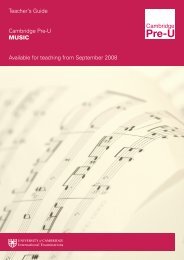Cambridge Pre-U Syllabus - Cambridge International Examinations
Cambridge Pre-U Syllabus - Cambridge International Examinations
Cambridge Pre-U Syllabus - Cambridge International Examinations
Create successful ePaper yourself
Turn your PDF publications into a flip-book with our unique Google optimized e-Paper software.
22<br />
<strong>Cambridge</strong> <strong>Pre</strong>-U Draft<br />
Practical learning outcomes<br />
Candidates should be able to:<br />
i) investigate genetics using locally available materials (e.g. locally available plants), germinating seedlings<br />
(e.g. rapid-cycling Brassica), Drosophila, fungi (such as Sordaria fimicola), genetic tomatoes, prepared<br />
materials such as ‘genetic corn-cobs’ and any other materials that yield suitable numerical information<br />
ii) investigate continuous and discontinuous variation with any available materials (e.g. people, plants with<br />
suitable single-gene and polygenic characteristics, polymorphic snails, etc.)<br />
1.7 Applications of cell biology<br />
Content<br />
Principles of genetic engineering<br />
Isolating genes<br />
Cloning DNA<br />
Vectors and insertion into host cells<br />
Identifying and cloning transformed cells<br />
Gene therapy and genetic profiling (DNA fingerprinting)<br />
Gene sequencing – methods and applications<br />
Stem cells – isolation and uses<br />
Ethical issues surrounding genetic engineering and the use of stem cells<br />
Learning outcomes<br />
Candidates should be able to:<br />
a) discuss the potential and actual advantages and disadvantages of transferring genetic material by<br />
genetic engineering compared to selective breeding<br />
b) explain why promoters and other control sequences may have to be transferred as well as the desired<br />
gene<br />
c) explain strategies that are available to isolate the desired gene from the genome of the gene-donor<br />
including:<br />
• use of mRNA and reverse transcriptase<br />
• use of restriction endonucleases to fragment the genome, and use of electrophoresis and<br />
complementary gene probes to identify relevant fragments from the gene<br />
d) outline the principles of PCR as used to clone and amplify DNA and discuss the source and importance<br />
of Taq polymerase<br />
e) explain strategies that are available to insert DNA into host cells including:<br />
• inserting the DNA into a plasmid vector using restriction enzymes and DNA ligase and then<br />
inserting the plasmid vector into a host cell<br />
• use of Agrobacterium tumefaciens in inserting DNA into dicotyledonous plant cells<br />
• use of microprojectiles in inserting DNA into monocotyledonous plant cells (e.g. in creating Golden<br />
Rice TM and Golden Rice 2)<br />
f) discuss the advantages and disadvantages of ways that have been used to identify transformed cells<br />
including antibiotic resistance genes and green fluorescent protein (GFP) genes<br />
g) outline how genes are inserted into target cells in gene therapy (limited to liposomes and viral vectors)<br />
h) explain the limitations, both potential and actual, of gene therapy as a treatment for genetic conditions<br />
(including cystic fibrosis and severe combined immunodeficiency [SCID])

















